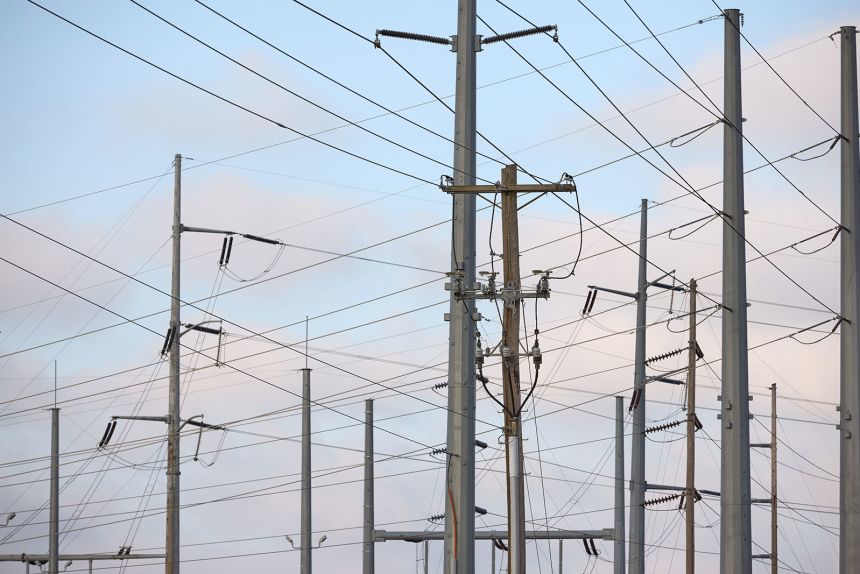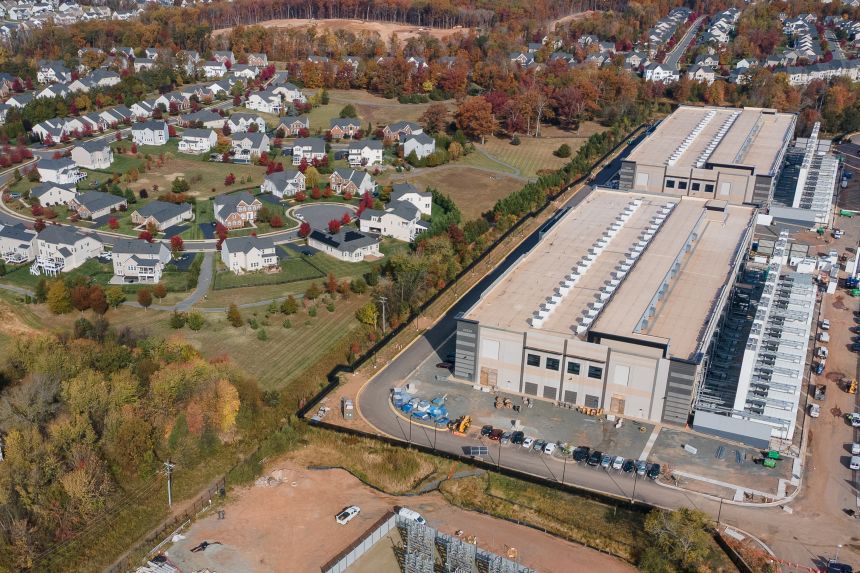Nike Carstarphen’s electricity bill is rising, even when she’s using less power.
The Baltimore resident’s electricity rate jumped 20% from August to September, even though she had cut her usage 40%, relying on her air conditioning less during a milder month.
She gets her power from Exelon-owned Baltimore Gas and Electric, whose prices jumped an additional $32 per month on average in September.
These higher costs are driven in large part by new neighbors in Northern Virginia: the world’s biggest cluster of nondescript, power-hungry data centers.
Data centers have powered the internet for years, but with the rise of artificial intelligence, they are projected to need eye-popping amounts of power, along with costly infrastructure upgrades to deliver it. A 2024 report by the US Department of Energy estimated that data centers would use between 6.7 and 12% of the nation’s electricity by 2028.

Utility customers in neighboring Maryland and Washington, DC, are some of the first in the country starting to see the impacts of the data center boom showing up on their residential electricity bills. The higher costs for BGE customers like Carstarphen are being spread across fall and spring months, when usage is typically low. But they don’t show up as a line item on the bill; the costs are tucked into customers’ electricity supply charges, which typically denote how much energy they consume each month.
“Existing customers are taking hits now and will take much greater hits going forward,” said Maryland People’s Counsel David Lapp, the state’s top official focused on consumer advocacy for utility bills.
Carstarphen noticed. Her August to September bills represented the biggest one-month increase in her electric supply costs this year.
Carstarphen uses AI for work, and she said she’s happy to pay more in her individual subscription fees for the data centers’ increased electricity needs. But she doesn’t think it’s fair to foist the costs onto everyone, including people who don’t use AI.
“We shouldn’t be subsidizing [the AI companies],” Carstarphen said. “They have enough money.”
As utility bills in the Mid-Atlantic region and other parts of the country start to balloon, there is an increasing push among states to make sure companies — not consumers — are the ones paying more for power and the high-voltage transmission lines needed to deliver it.

Measures to do so in states like Ohio have been opposed by big tech companies, which are pushing to spread costs to other users. But some of these same companies that operate Virginia data centers, including Microsoft and Google, say they already cover the cost of their own energy and favor protecting residential ratepayers. CNN also reached out to Amazon — which has a major data center footprint in Virginia — but a spokesperson declined to comment.
“Microsoft pays for the electricity we consume and for our share of infrastructure costs to generate and deliver that electricity to our sites,” Microsoft’s vice president of energy Bobby Hollis told CNN in a statement. Hollis said the company supports utility and regulatory work “to make sure these costs are transparently calculated and assigned to us.”
“This work helps ensure that our neighbors and the local community do not pay for our share.”
The trouble is, these rising costs aren’t just about electricity being used and infrastructure being built right now. Customers are also paying for the future.
There are two main ways data centers have driven up costs in Maryland and other mid-Atlantic states: by needing lots of electricity that is available even at peak demand, and by needing new infrastructure deliver that electricity.
Maryland is one of 13 states, plus DC, that are part of a little-known nonprofit called PJM Interconnection, which helps to make sure there’s enough electricity to meet demand and to move it where it’s needed. PJM is one of 10 regional grid operators in the country — all of them crucial to keeping the lights on.
The September spike showing up on Carstarphen’s bill is also coming from what markets anticipate the data centers will need in the future. Because demand for electricity is expected to climb, PJM needs more on deck, accessible years from now. And that future generation is expensive. During the most recent price auction, prices had jumped over 1,000% compared to two years prior. If it were not for a cap added at the last minute, the increase would have been even higher.

The spike in Mid-Atlantic states was driven both by that massive future data center demand and by the fact that the generation capacity in the region has been simultaneously falling.
It represents “the tip of the iceberg,” according to Marina Domingues, head of US new energies at Norwegian firm Rystad Energy. “There’s so much more to come because of that increased need for power and upgrades.”
PJM spokesperson Jeffrey Shields said regional data center growth is “substantially” driving higher prices through normal supply-and-demand imbalance.
However, independent watchdog group Monitoring Analytics, which tracks PJM’s price auctions, said in a recent report that it would be “misleading” to call this situation a simple supply-and-demand mismatch.
Monitoring Analytics said the current price spikes “are almost entirely the result of large load additions from data centers,” and that data centers alone inflated PJM’s latest power price auction by over $9.3 billion.
The report said the data center explosion was “unique and unprecedented and uncertain” and required “a different approach than simply asserting that it is just supply and demand.”
Other costs are looming. In the last two years, PJM has proposed over $11 billion or more in transmission upgrades in the region, primarily to serve new data center load growth.
These costs are shouldered by utilities, who pass them on to ratepayers — spreading the expenses over decades of line-item bill fees. Including rate of return, the cost could eventually top out around $40 billion, said Lapp, the Maryland consumer advocate.
“We’re looking at the equivalent of Maryland’s (entire electricity) demand built up over more than a century, being built in Northern Virginia in five years,” Lapp said.
PJM’s system has long been designed to spread the costs of building electrical infrastructure across its whole region, on the idea that such infrastructure will directly benefit the public that pays for it, regardless of which utility their bill comes from. But a recent Harvard Law School paper found that Virginia and Maryland ratepayers are on the hook for the lion’s share of transmission being built to accommodate, not residential customers, but Virginia’s data center growth.
“Without reforms, consumers will be paying billions of dollars for regional infrastructure that is designed to address the needs of just a few of the world’s wealthiest corporations,” wrote legal fellow Eliza Martin and Ari Peskoe, director of the Harvard Law School’s electricity law initiative. “Residential ratepayers are not causing PJM to plan new transmission.”
Exelon, a company that owns several Mid-Atlantic utilities including BGE, requires data centers to “pay for transmission services in proportion to the load they request, ensuring that any revenues are credited back to residential and small business customers,” an Exelon company spokesperson told CNN in a statement.
Maryland is far from alone; rising electricity bills are quickly becoming a hot-button issue all over the country. Power bills are spiking in other data center growth spots, including Ohio and Georgia. In Ohio, officials came up with a plan to alleviate the burden by designating data centers as a new type of utility customer — and mandating they pay more for the power and equipment.
Lapp is focused on trying to do something similar.

Utility companies told CNN they are aware of ballooning costs. An Exelon spokesperson said it is working with regional governors and a data center industry group to address the problem.
But Maryland is already in what Lapp calls an “affordability crisis” dominated by high gas bills. Electricity generation in the state is also highly dependent on the price of gas. Last winter, cold weather and infrastructure costs suddenly spiked some Baltimore gas bills by hundreds, or in some instances, over $1,000.
“If we don’t get the answer right, which is that data centers should be fully responsible for all the costs that they are causing, it’s going to get much worse than it is now,” Lapp said.
Carstarphen, the Baltimore resident, is actively exploring electrifying her home because her gas bill has been so high in recent years. She wants to add rooftop solar, both to keep her costs down and help reduce her environmental impact.
“I’d love to be off the grid, so I don’t have to think about this ever again,” she said.
In the meantime, it’s been incredibly demoralizing to try to limit her own energy usage — sometimes sacrificing comfort in cold and hot seasons — all while seeing her costs go up.
“You’re trying to be more efficient. You even buy more efficient stoves and refrigerators and air conditioning systems,” she said. “You feel like you’re doing the right thing, but there’s no reward.”
There’s a feeling she has — that she believes is pervasive around the country — that Americans can see they are paying more for groceries, utility bills and taxes, but getting less for their money.
“That’s what I think is infuriating to me, personally,” she said. “When do we get a break?”
